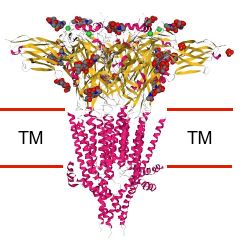Introduction of 5-HTR3B
5-hydroxytryptamine receptor 3B (5-HTR3B), also known as serotonin receptor 3B, is one of the type 3 receptors for 5-hydroxytryptamine (serotonin), a biogenic hormone which acts as a neurotransmitter, a hormone, and a mitogen. The 5-HTR3B receptor is a ligand-gated ion channel and in human is encoded by the HTR3B gene. The 5-HTR3B receptors are co-expressed with the 5-HTR3A subunit in the amygdala, hippocampus and caudate. They are also found in the kidney and testis as well as in monocytes of the spleen, small and large intestine, prostate, uterus, ovary, and placenta.
| Basic Information of 5-HTR3B | |
| Protein Name | 5-hydroxytryptamine receptor 3B |
| Gene Name | HTR3B |
| Aliases | Serotonin receptor 3B, 5-HT3-B, 5-HT3B |
| Organism | Homo sapiens (Human) |
| UniProt ID | O95264 |
| Transmembrane Times | 4 |
| Length (aa) | 430 |
| Sequence | MIVYFPGILATDTHHPQDSALYHLSKQLLQKYHKEVRPVYNWTKATTVYLDLFVHAILDVDAENQILKTSVWYQEVWNDEFLSWNSSMFDEIREISLPLSAIWAPDIIINEFVDIERYPDLPYVYVNSSGTIENYKPIQVVSACSLETYAFPFDVQNCSLTFKSILHTVEDVDLAFLRSPEDIQHDKKAFLNDSEWELLSVSSTYSILQSSAGGFAQIQFNVVMRRHPLVYVVSLLIPSIFLMLVDLGSFYLPPNCRARIVFKTSVLVGYTVFRVNMSNQVPRSVGSTPLIGHFFTICMAFLVLSLAKSIVLVKFLHDEQRGGQEQPFLCLRGDTDADRPRVEPRAQRAVVTESSLYGEHLAQPGTLKEVWSQLQSISNYLQTQDQTDQQEAEWLVLLSRFDRLLFQSYLFMLGIYTITLCSLWALWGGV |
Function of 5-HTR3B Membrane Protein
5-hydroxytryptamine or 5-HTR, also known as the neurotransmitter serotonin receptor, mediates rapid excitatory responses through 5-HTR3 receptors (ligand-gated channels). The 5-HTR3B receptor is a cation-specific, but otherwise relatively nonselective ion channel, which causes fast, depolarizing responses upon activation. Activation of 5-HTR3 receptors generates a range of effects, such as membrane depolarization and increase in intracellular Ca2+, Ca2+ influx into lymphocytes, modulation of neurotransmitter release, excitation of central and peripheral neurons, and release of 5-HTR from enterochromaffin cells of the small intestine. Studies indicated that 5-HTR3B may play a role in tissue-specific functional changes of 5-HTR3-mediated signaling and/or modulation. Although 5-HTR3B seems to be unable to function as an α-subunit in homomers or in combination with nicotinic ACh receptor β-subunits, it is supposed to be involved in modifying 5-HTR3A receptor function and altering the desensitization of 5-HTR3A receptors.
 Fig.1 Structure of mouse 5-HTR3B membrane protein.
Fig.1 Structure of mouse 5-HTR3B membrane protein.
Application of 5-HTR3B Membrane Protein in Literature
The authors of this study focused on the evaluation of the association of anti-emetic efficacy of ondansetron with 18792A>G polymorphism in the target gene of 5-hydroxytryptamine type 3 subtype B.
The results attempted to evaluate the effect of seven alkaloids in Uncaria hook on the hydroxytryptamine type-3 (5-HT3) receptor ion channel and showed that six alkaloids weakly inhibited the 5-HT-mediated 5-HT3A and/or 5-HT3AB receptor current.
The findings of this study indicated that the AAG deletion in both alleles of the 5-HT3B receptor gene appeared to be related to a higher incidence of PONV.
Authors of this study suggested that over 25% of anticancer drugs tested in this study inhibited or potentiated the 5-HT3 receptor current.
The findings of this article suggested that the response to ondansetron for PONV was significantly influenced by the -100_-102AAG deletion polymorphisms of the 5-HT3B gene.
5-HTR3B Preparation Options
Our Magic™ membrane protein production platform provides you with many flexible options, which enables robust reconstitution forms as well as multiple active formats for membrane proteins. To obtain the soluble and functional target protein of your interest, our experienced scientists offer customized services with fast turnaround times. Aided by our versatile Magic™ anti-membrane protein antibody discovery platform, we also provide customized anti-5-HTR3B antibody development services.
Creative Biolabs has established high-quality and efficient procedures for membrane protein preparation, to provide a comprehensive solution for membrane protein studies. Our scientists are devoting themselves to solve the toughest problems in membrane protein preparation. Please feel free to contact us for technical support.
All listed services and products are For Research Use Only. Do Not use in any diagnostic or therapeutic applications.